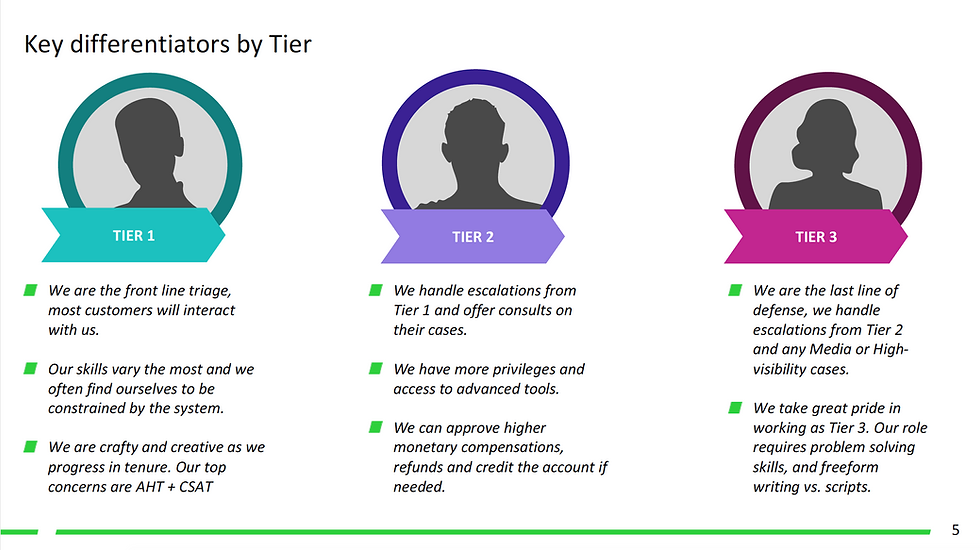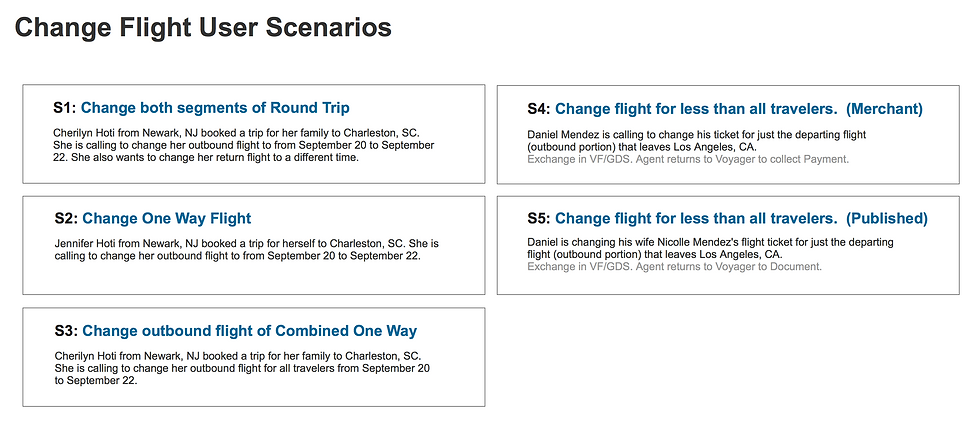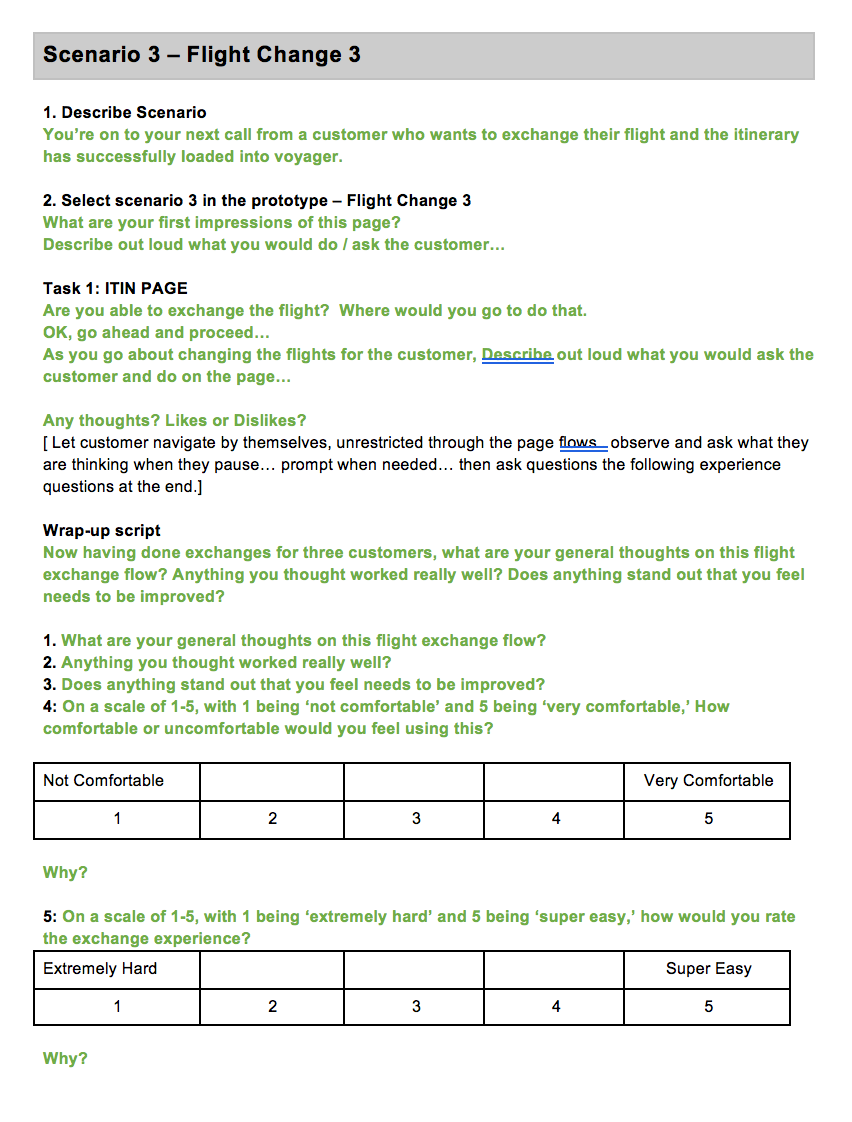Wilo Dietrich
Background
Expedia Group branded customer care support agents (located throughout Philippines, San Salvador, Egypt, North America) face the challenge of having to use different tools and applications (GDS, Classic Voyager, Voyager Flights, Eureka, Brand Site for Agents, etc.) to exchange customer flight bookings. On the Voyager Flights tool, agents have to manually determine penalty, change fee policy, and booking class rules which if done inaccurately lead to airline debit memos that adversely impact the business.
Incomprehensible system errors due to issues in downstream services and the inability to display information due to out of sync booking information when backend systems pull from different data stores also add to the pain points agents experience. When the agents don't know what their next step should be to resolve their customer's problems it leads to dissatisfaction. Tier 2 and Tier 3 agents have to memorize 15+ key commands for the different GDS systems they use to service flight bookings. There existed an opportunity to make a more user friendly interface that could quickly give the agents the information they need and reduce their average handling time.
Design Process
My Role
As the main designer on the project, I worked with the business owner, creative director, product managers, program managers, content strategist, testers, developers, service & delivery, and learning development teams to alleviate the customer pain points and improve the experience faced by the phone agents on complex flight exchange cases. I was a mentor to the designer working on customer self-service flight change. I drafted a design schedule for both our areas and reviewed the other designer's work. I designed around the constraints of an existing visual and interaction style guide and took into consideration the agent's current work flow for how they exchange flights in their current tool. I looked at their mental model for how other products were exchanged in the tool that I'd be building upon. I made design prioritization tradeoffs due to technical and resource limitations and followed design principles around simplicity, focus, clarity and efficiency in the user experience.
Customer Needs
• Improve user experience and increase user confidence. Make it easy and efficient for call center agents to service US and Canadian point of sale flight booking exchanges.
• Improve CSAT (customer satisfaction) for high volume and high effort calls.
• Reduce the customer effort required for 31% of flight exchanges
Business Goals
• Reduce operating costs and optimize the business by increasing the customer's ability to self-service.
• Reduce AHT (average handling time) and agent error costs.
• Reduce call propensity by at least 1% (target: 20%).
Understanding the user: Call Center Agents
When I interviewed and observed call agents at the different customer care centers, I saw they were on the phone with the customer an average of 5 to 15 minutes for simple cases and 30 minutes for complex ones. And, in extreme cases, like those due to weather related schedule changes, an agent could spend 1.5 hours on the phone with the customer and airlines. Customer call time increases for cases that need higher tier level agents/supervisors access and approval.



Call center agents are able to exchange flights for customers.

Call center agents are able to exchange flights for customers.
Design Planning
• Participated in Project Inceptions to gain a shared vision of business priorities, strategy and project scope from Product Management, Line of Business, Development, and additional cross-functional teams. Met with Learning & Development to understand agent workflows and flight exchange and cancel policies and Content Strategists on the Eureka Knowledge Base Tool that agents depend on.
• Drafted and presented design schedule to product management and development/test teams based on dev milestones and the scope of the project.
• Participated in working sessions with PM/DEV/TEST to discuss project scope and technical constraints. Group white boarding sessions to agree on user experience and user flow with shared understanding of data model, and business requirements.
• Created an html design index and Confluence page for the project that displayed the task flow diagrams and links to prototype, mockups deliverables, and redlines/annotations.
Understanding the problem space
Met with my PM/Business owner to gain more background on the flight business and strategy on why the project was important. I learned about the tools the agents use and training they go through.


Research
• Observed and interviewed call center agents to understand their workflow and escalation process for the different agent types: Tier 1, Tier 2, and Tier 3 (Complex Air Agents).
• Consulted with subject matter expert from the service delivery team and the line of business product managers on knowledge collected from past survey results and call center agent visits. The goal was to understand the issues that had the biggest impact on the business and the user experience pain points.
• Competitive analysis and heuristic evaluation of airline websites (United, Alaska, etc.).
• Task analysis and evaluation of the current user experience (Voyager Flights tool) that was being used to exchange, cancel, and void flights by Tier 1 agents in US/CANADA.
• Researched how the GDS is being used by Tier 2 agents and Complex Air agents.
User Scenarios
Identified key scenarios and use cases. Created wireframe screens in Sketch. Built out multiple prototypes in Axure for usability testing.


User Task Flow Diagram
I delivered scenario flows for the different use cases and handed off design for the following screen deliverables: Select Flights/Travelers, Search, Search Results, Review, Confirmation, and confirmation email template. I contributed to the style guide by introducing a new layout pattern on the Review screen for displaying the amount due for a flight exchange.
For the customer self-service portion, I delivered on the review, checkout, and confirmation user experience and ensured the end to end self-service flow worked for responsive web.


Design Deliverables
Created an html index page for the designs. Planned for a design schedule that took into consideration the multiple design iterations with usability testing as well as feedback from reviews with business owners.



Drafted a schedule and worked with dev team on alignment of the design deliverable dates would work with the dev milestones.

Drafted a schedule and worked with dev team on alignment of the design deliverable dates would work with the dev milestones.
Focus Group Session
Agents prioritized most common used tasks they use in Voyager Flights.


Usability Testing
• Created usability test scripts and identified demographics of the test participants. Reached out to service delivery team to obtain call center availability and participants.
• Conducted iterative usability testing and focus group sessions both remote and in-person with agents in the following locations: Manila, Philippines and San Sal, EL Salvador.
• Created Qualtrics survey that obtained feedback from 400+ agents in both North America and international call centers for the multiple informational alerts that can display on flight itinerary page.


Drafted usability test script and reviewed it with stakeholders.

Drafted usability test script and reviewed it with stakeholders.
UX Reviews
• Held weekly UX design reviews (Product Management, Design, Content) to work on deliverables.
• Reviewed designs with Expedia.com designers who were working on flight booking to knowledge share.
• Reviewed designs with SMEs and business owners from impacted groups and updated designs per feedback received.
• Held design-tech meetings with development and test teams for tech feasibility checks on different ui design options.
• Worked with Learning & Development teams to provide screenshots for training materials. Presented designs to call center agents in San Salvador for UAT rollout.
Select Flights & Travelers Page
Review Page


Technical Scope & Development Constraints that required design consideration
• Not able to build out all search parameters during the first phase of the project. Made recommendations for which search parameters would have the most user benefit to build out.
• Error messages were not all identifiable. Needed to anticipate and address most common problematic ones.
• Not able to support less than all travelers on a flight exchange.
• Not able to build out new progress bar design due to shared code and resource time limitations for testing.
• Not able to update the payment widget due to legacy code with unknown dev dependencies that could be problematic.
• Needed to leverage existing visual and interaction style guide and flight itinerary page that was already created. Introduced new styles to compensate and fill in gaps.
• Certain use cases could not be supported in the mvp timeline. (Example: No infants, minors, or basic economy fares can be exchanged. No multi-destination bookings.)
• Not all fare rules for all booking types were parseable.
• Not able to display the relevant policies or hyperlinks to the knowledge base.
Design Development
• Participated in sprint story planning and user story writing sessions with PM, Content, Dev and Test.
• Deliverables were agreed on and planned out in 2 week cycles for the next four months.
• Daily standup meetings with dev team to answer design questions or adjust designs based on backend issues and time constraints.
Interaction design spec


• Delivered final mockups, prototype, and annotated interaction redlines for the different use cases.
• Worked with css designer for hand-off of html code to developers.
• Buddy-testing meetings and side-by-side review of coded designs with developers.
• Participated in build reviews and bug prioritization meetings with PM, Dev, and Test.
• Partnered with pm/dev/test to determine process and severity levels for filed bugs.
Final Design
Future Design Thinking
Upon completion of the flight exchange initiative, I went into strategic design planning for flight void and cancel both for the agent-facing and self-service customer experiences. I delivered a deck that outlined planned deliverables.
For the agent-facing work, I created the mockups, iterative prototypes, and conducted multiple usability tests for different use cases (void, cancel with airline credit, cancel with refund, and cancellations involving fees).
Similar to the above flight exchange project, I reviewed designs and presented the usability results and customer insights to stakeholders (product managers, development team, line of business, service delivery, and learning & development teams).
Project starting in 2016 was part of a multi-year initiative that would take several years to reach completion. Impact and success was measure tied to increasing the amount of flights that can be serviced and having a downward trend in call propensity. Benchmark tests show that a year after the flight exchange portion of the project launched, out of 1600 calls, 70% of flights can be serviced in Voyager without having to go to the GDS.
